-
Countries
-
Data and Analysis
-
Special Focus
-
Crisis Responses
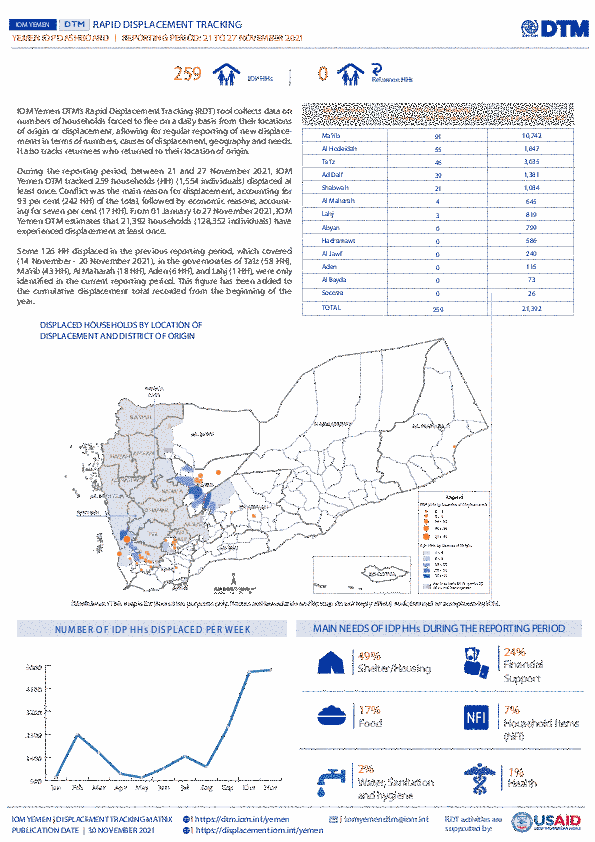
Contact
DTM Yemen, iomyemendtm@iom.int
Language
English
Location
Yemen
Period Covered
Nov 21 2021
Nov 27 2021
Activity
- Rapid Emergency Registration
- Mobility Tracking
IOM Yemen DTM’s Rapid Displacement Tracking (RDT) tool collects data on numbers of households forced to flee on a daily basis from their locations of origin or displacement, allowing for regular reporting of new displacements in terms of numbers, geography, and needs. It also tracks Returnees who returned to their location of origin.
From 01 January 2021 to 27 November 2021, IOM Yemen DTM estimates that 21,392 households (HH) (128,352 Individuals) have experienced displacement at least once.
Since the beginning of 2021, DTM also identified 3,814 displaced households who left their locations of displacement and either moved back to their place of origin or another location.
Between 21 and 27 November 2021, IOM Yemen DTM tracked 259 households (1,554 individuals) displaced at least once. The top three districts of the top three governorates that saw the highest number of displacements were:
- Marib (91 HH) – Marib City (59 HH), Marib (32 HH) districts. Most displacements in the governorate originated from Marib and Shabwah.
- Al Hodeidah (55 HH) – Hays (55 HH) district. Most displacements in the governorate were internal.
- Taiz (46 HH) – Al Makha (10 HH), Jabal Habashi (7 HH), Al Qahirah (7 HH) districts. Most displacements in the governorate originated from Al Hodeidah and Taiz.
Most displacements resulted from the increased conflict in the following governorates and districts.
- Al Hodeidah (82 HH) – Hays (37 HH), Al Jarrahi (21 HH), Jabal Ras (6 HH) districts.
- Marib (66 HH) – Al Jubah (25 HH), Sirwah (14 HH), Harib (14 HH) districts.
- Shabwah (37 HH) – Ayn (22 HH), Bayhan (13 HH), Osaylan (2 HH) districts.
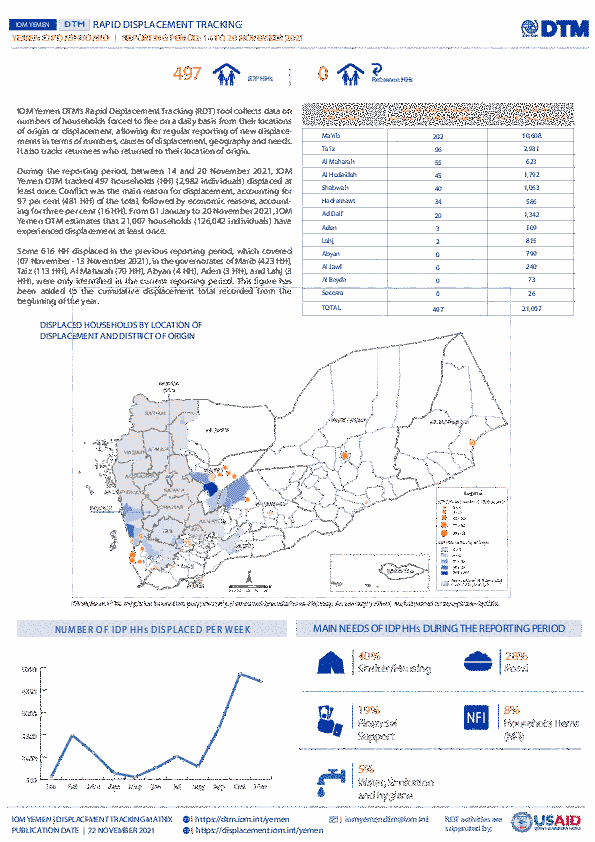
Contact
DTM Yemen, iomyemendtm@iom.int
Language
English
Location
Yemen
Period Covered
Nov 14 2021
Nov 20 2021
Activity
- Rapid Emergency Registration
- Mobility Tracking
IOM Yemen DTM’s Rapid Displacement Tracking (RDT) tool collects data on numbers of households forced to flee on a daily basis from their locations of origin or displacement, allowing for regular reporting of new displacements in terms of numbers, geography, and needs. It also tracks Returnees who returned to their location of origin.
From 01 January 2021 to 20 November 2021, IOM Yemen DTM estimates that 21,007 households (HH) (126,042 Individuals) have experienced displacement at least once.
Since the beginning of 2021, DTM also identified 3,814 displaced households who left their locations of displacement and either moved back to their place of origin or another location.
Between 14 and 20 November 2021, IOM Yemen DTM tracked 497 households (2,982 individuals) displaced at least once. The top three districts of the top three governorates that saw the highest number of displacements were:
- Marib (202 HH) – Marib City (142 HH), Marib (60 HH) districts. Most displacements in the governorate were internal.
- Taiz (96 HH) – Al Makha (89 HH), Al Waziyah (7 HH) districts. All displacements in the governorate orginiated from Al Hodeidah.
- Al Maharah (55 HH) – Al Ghaydhah (52 HH), Sayhut (3 HH) districts. Most displacements in the governorate originated from Taiz and Ibb.
Most displacements resulted from the increased conflict in the following governorates and districts.
- Marib (203 HH) – Al Jubah (169 HH), Sirwah (12 HH), Harib (9 HH) districts.
- Al Hodeidah (169 HH) – At Tuhayta (82 HH), Hays (43 HH), Ad Durayhimi (17 HH) districts.
- Shabwah (34 HH) – Osaylan (19 HH), Bayhan (10 HH), Ayn (5 HH) districts.

Contact
DTM Burkina Faso, bfinformationunit@iom.int
Language
French
Location
Burkina Faso
Period Covered
Sep 01 2021
Sep 30 2021
Activity
- Survey
- Flow Monitoring Survey
- Flow Monitoring
Au Burkina Faso, la DTM recueille des données au niveau de 4 Points de suivi des flux (Flow Monitoring Points, FMP), que sont Dori/Seytenga, Kantchari, Faramana et Yendéré répartis dans 4 régions afin d’obtenir une meilleure compréhension de l’ampleur, des tendances, des caractéristiques socio-démographiques et des parcours des flux de voyageurs traversant ces différents points.
Ce rapport présente les données recueillies dans le cadre des activités d’enregistrement des flux et des enquêtes individuelles durant le mois de Septembre 2021.
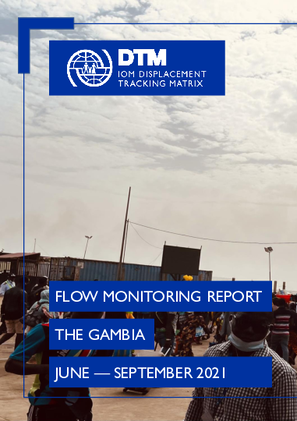
Contact
Kumbale GOODE, KuGoode@iom.int
Language
English
Location
The Gambia
Period Covered
Jul 01 2021
Sep 30 2021
Activity
- Survey
- Flow Monitoring Survey
- Flow Monitoring
In The Gambia, DTM conducts Flow Monitoring activities at several important transit locations: in 1) Barra (FMPs are located at the ferry terminal and the main garage); 2) Farafenni (FMPs are located at Farafenni main garage, Farafenni Ballan-Ghar garage, Farafenni McCarthy and Sanjally garage, Farafenni turntable garage and the truck garage); 3) Basse (FMPs are situated at the main garage and the bus station in Basse Santa-Su) and 4) Brikama (FMPs are located at the main garage and the Bus station). These activities enable DTM to monitor the movements of passenger within The Gambia, out of and towards The Gambia as well as transiting The Gambia.
This report presents the key results from the Flow Monitoring Survey conducted with travellers between June and September 2021. The report presents data collected on flows, routes, provenance, destination and demographic profiles of travellers observed at the FMPs.
Contact
DTM Ethiopia, SLOAddisAbabaDTM@iom.int
Location
Ethiopia
Activity
- Mobility Tracking
- Village Assessment
Period Covered
Aug 16 2021 -Sep 23 2021
A village assessment survey (VAS) is a sub-component of mobility tracking. It collects data on returning IDPs, returned migrants and host community members. VAS evaluates the absorption capacity of villages to receive returning IDPs with a focus on accessibility of services, livelihoods and reintegration.
Population Groups
Survey Methodology
Unit of Analysis Or Observation
Type of Survey or Assessment
Keywords
Geographical Scope
Administrative boundaries with available data
The current dataset covers the following administrative boundaries
Contact
DTM Ethiopia, SLOAddisAbabaDTM@iom.int
Location
Ethiopia
Activity
- Site Assessment
- Mobility Tracking
Period Covered
Aug 15 2021 -Sep 23 2021
A site assessment is a sub-component of mobility tracking. It aims to collect data on population presence, living conditions and needs in a particular displacement site or community.
Population Groups
Survey Methodology
Unit of Analysis Or Observation
Type of Survey or Assessment
Keywords
Geographical Scope
Administrative boundaries with available data
The current dataset covers the following administrative boundaries

Contact
DTM Libya, DTMLibya@iom.int
Language
English
Location
Libya
Period Covered
Dec 05 2021
Dec 11 2021
Activity
- Other
As part of the national COVID-19 vaccination campaign led by the Libyan National Centre for Disease Control (NCDC), IOM conducted awareness-raising sessions on COVID-19 vaccines for a total of 200 adult migrants in community settings in three municipalities during the tenth week. Trained IOM community mobilizers, accompanied by medical teams provided the migrants with critical information on COVID-19 vaccines, including its importance, dosage, side effects and addressed questions and concerns related to the vaccination processes. During the tenth week, 320 people (193 migrants and 127 Libyans) have received either Sinopharm or AstraZeneca vaccines.
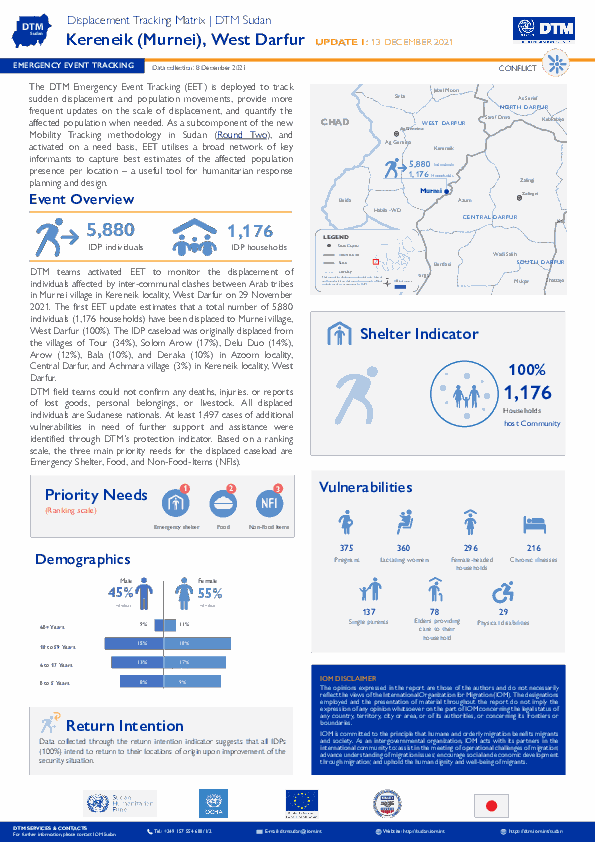
Contact
DTM Sudan; dtmsudan@iom.int
Language
English
Location
Sudan
Snapshot Date
Dec 08 2021
Activity
- Event Tracking
- Mobility Tracking
The DTM Emergency Event Tracking (EET) is deployed to track sudden displacement and population movements, provide more frequent updates on the scale of displacement, and quantify the affected population when needed. As a subcomponent of the new Mobility Tracking methodology in Sudan (Round Two), and activated on a need basis, EET utilises a broad network of key informants to capture best estimates of the affected population presence per location – a useful tool for humanitarian response planning and design.
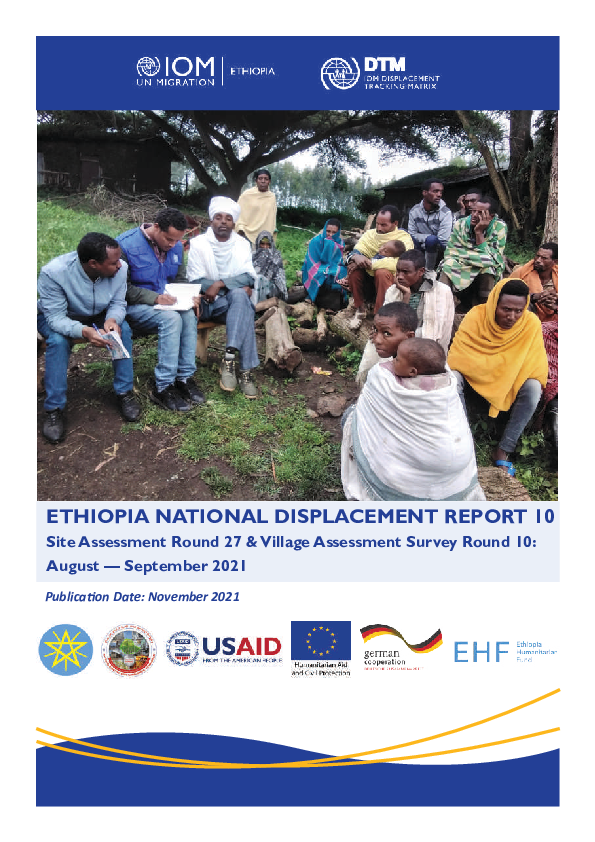
Contact
DTM Ethiopia, SLOAddisAbabaDTM@iom.int
Language
English
Location
Ethiopia
Period Covered
Aug 15 2021
Sep 23 2021
Activity
- Site Assessment
- Mobility Tracking
- Village Assessment
In order to capture the displacement and return dynamics in Ethiopia, DTM Ethiopia's National Displacement Report combines findings from its Site Assessment (SA) in Section 1 and findings from the Village Assessment Survey (VAS) in Section 2. The Site Assessment tracks the number and multi sectoral needs of internally displaced persons (IDPs), while the Village Assessment Survey tracks the number of IDPs who are returning or have returned to their communities and their multi sectoral needs. VAS is also used to evaluate the absorption capacity of villages receiving returns with a focus on accessibility of services, livelihoods and reintegration.
As of September 2021, a total of 4.23 million IDPs have been identified thus far across the country. Through Site Assessment (SA), a total of 2.12 million IDPs were identified in 1,577 sites across 9 regions in Ethiopia. Simultaneously, 2.11 million IDPs were also tracked through the Emergency Site Assessment (ESA) round 8 which is a monthly tool used to track internal displacement in Tigray, Afar and Amhara regions caused by the Northern Ethiopia Crisis. Of the total displaced population, the main causes of displacement were conflict which displaced 3.5 million IDPs (85%), drought which displaced 307,871 IDPs (7%) and seasonal floods which displaced 139,199 IDPs (3%).
Through Village Assessment Survey, a total of 1.5 million returning IDPs were identified in 1,172 villages across 9 regions. A large majority of returning IDPs (1.4 million) were initially displaced due to conflict while 61,295 returning IDPs were initially displaced due to flash floods and 54,095 returning IDPs due to seasonal floods. The region hosting the largest number of returning IDPs was Oromia region with 653,549 returning IDPs, followed by Somali region with 392,286 returning IDPs. However, please note that there were considerable access and/or security issues in Amhara, Benishangul Gumz, Oromia and Tigray regions which affected the total displacement and return count.

Contact
DTM Sudan; dtmsudan@iom.int
Language
English
Location
Sudan
Snapshot Date
Dec 08 2021
Activity
- Event Tracking
- Mobility Tracking
The DTM Emergency Event Tracking (EET) is deployed to track sudden displacement and population movements, provide more frequent updates on the scale of displacement, and quantify the affected population when needed. As a subcomponent of the new Mobility Tracking methodology in Sudan (Round Two), and activated on a need basis, EET utilises a broad network of key informants to capture best estimates of the affected population presence per location – a useful tool for humanitarian response planning and design.
